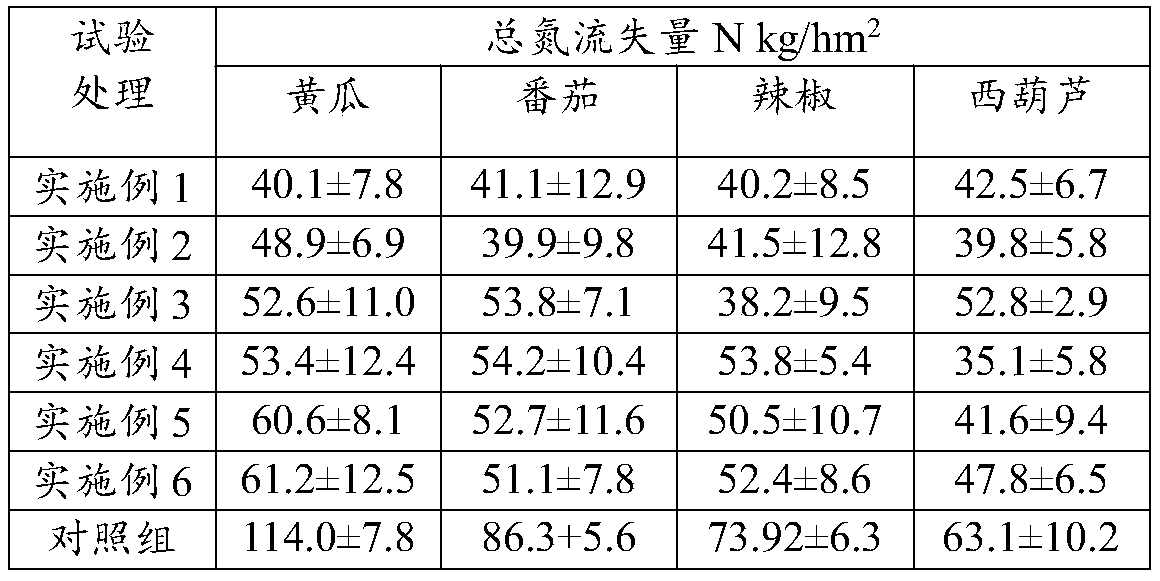Farmland nitrogen and phosphorus emission combined resistance control method
A technology of resistance control and farmland, applied in the direction of soil preparation, agriculture, fertilizer mixture, etc., can solve the problems of pollution, groundwater nitrate pollution, etc., achieve the effect of material economy, increase utilization rate, and increase carbon-nitrogen ratio
- Summary
- Abstract
- Description
- Claims
- Application Information
AI Technical Summary
Problems solved by technology
Method used
Image
Examples
Embodiment 1
[0046] A method for joint prevention and control of nitrogen and phosphorus discharge in farmland, comprising the following steps:
[0047] a In the lower layer of the crop root system, set up a barrier system for the farmland leaching layer, dig the farmland soil of the facility to a depth of 50 cm in the risk layer of leaching loss, lay a barrier layer composite material with a thickness of 6 cm, and compact it. Backfill to the root distribution layer of the crop.
[0048] The composition of the barrier layer composite material is as follows in parts by weight: 25 parts of straw-based hydrogel, 20 parts of edible fungus residue, 35 parts of bentonite, and 5 parts of corn flour.
[0049] b In the distribution layer of the crop root system, according to the ratio of 1:1:1, add the composite microbial agent composed of Bacillus fermentum, Bacillus subtilis, and Bacillus amyloliquefaciens, and add 150% edible fungus slag by weight at the same time. 20 parts of straw-made hydrog...
Embodiment 2
[0055] A method for joint prevention and control of nitrogen and phosphorus discharge in farmland, comprising the following steps:
[0056] a In the lower layer of the crop root system, set up a barrier system for the farmland leaching layer, dig the farmland soil of the facility to a depth of 50 cm in the risk layer of leaching loss, lay a barrier layer composite material with a thickness of 6 cm, and compact it. Backfill to the root distribution layer of the crop.
[0057] The composition of the barrier layer composite material is as follows in parts by weight: 30 parts of straw-based hydrogel, 25 parts of edible fungus residue, 40 parts of bentonite, and 5 parts of corn flour.
[0058] b In the distribution layer of the crop root system, according to the ratio of 1:1:1, add the composite microbial agent composed of Bacillus fermentum, Bacillus subtilis, and Bacillus amyloliquefaciens, and add 150% edible fungus slag by weight at the same time. 20 parts of straw-made hydrog...
Embodiment 3
[0064]A method for joint prevention and control of nitrogen and phosphorus discharge in farmland, comprising the following steps:
[0065] a In the lower layer of the crop root system, set up a barrier system for the farmland leaching layer, dig the farmland soil of the facility to a depth of 50 cm in the risk layer of leaching loss, lay a barrier layer composite material with a thickness of 6 cm, and compact it. Backfill to the root distribution layer of the crop.
[0066] The composition of the barrier layer composite material is as follows in parts by weight: 35 parts of straw-based hydrogel, 30 parts of edible fungus residue, 50 parts of bentonite, and 6 parts of corn flour.
[0067] b In the distribution layer of the crop root system, according to the ratio of 1:1:1, add the composite microbial agent composed of Bacillus fermentum, Bacillus subtilis, and Bacillus amyloliquefaciens, and add 150% edible fungus slag by weight at the same time. 20 parts of straw-made hydroge...
PUM
| Property | Measurement | Unit |
|---|---|---|
| depth | aaaaa | aaaaa |
| depth | aaaaa | aaaaa |
Abstract
Description
Claims
Application Information
 Login to View More
Login to View More - R&D
- Intellectual Property
- Life Sciences
- Materials
- Tech Scout
- Unparalleled Data Quality
- Higher Quality Content
- 60% Fewer Hallucinations
Browse by: Latest US Patents, China's latest patents, Technical Efficacy Thesaurus, Application Domain, Technology Topic, Popular Technical Reports.
© 2025 PatSnap. All rights reserved.Legal|Privacy policy|Modern Slavery Act Transparency Statement|Sitemap|About US| Contact US: help@patsnap.com


